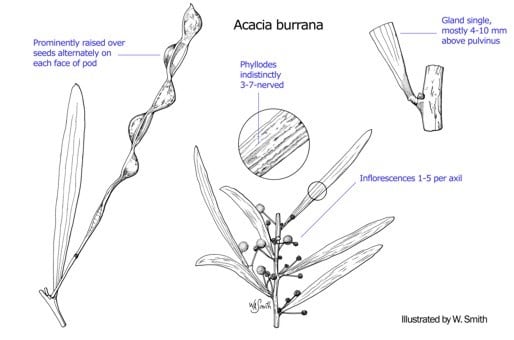Acacia burrana Pedley
WATTLE
Acacias of Australia
Family
Fabaceae
Distribution
Occurs in Qld in the Petford–Herberton–Mt Garnet area and the Great Dividing and Lolworth Ranges at the headwaters of the Cape R. and Torrens Ck, with an isolated occurrence 300 km S in Cudmore Natl Park.
Description
Glabrous shrub to 1–5 m high. Branchlets slender, angular, dark reddish brown. Phyllodes narrowly oblanceolate or occasionally narrowly elliptic, straight to shallowly incurved, size variable, (3.5–) 4–8 (–9) cm long, (3–) 4–9 (–11) mm wide, obtuse, with 3–7 rather indistinct, widely spaced longitudinal nerves and sometimes with obscure longitudinally anastomosing minor nerves in between; gland obscure, (3–) 4–10 (13) mm above pulvinus. Inflorescences simple or rudimentary racemes 0.5–1.5 mm long, 1–5 per axil; peduncles slender when in flower (thicker in fruit), 5–10 (–15) mm long, basal bract persistent; heads globular, c. 5 mm diam., 20–30-flowered, golden; bracteoles obtuse, inconspicuous in buds. Flowers 5-merous; sepals free. Pods linear, slightly to moderately constricted between the seeds and strongly domed over them alternately on each side (convexity extending to the margin), with a depression on the valve opposite the convexity, to 9 cm long, 5–6 (–7) mm wide. Seeds longitudinal, oblong, 3.2–4 mm long, black, not markedly shiny; funicle expanded into a keeled leaf-like aril on one side of seed.
Habitat
Grows above 500 m altitude on shallow sandy soils often derived from sandstone, reported in association with Corymbia trachyphloia or Acacia shirleyi and occasionally at lower elevations on sandy creek banks.
Specimens
Qld: “Warang” Holding, White Mountains, D.Fell DF1307A et al. (BRI); Mt Garnet aerodrome, P.I.Forster PIF30644 et al. (BRI, DNA n.v., K n.v., MEL); Burra Range lookout, P.Jobson 467 (BRI, CANB n.v., HO n.v., MEL n.v.).
Notes
Acacia burrana is related to both A. multisiliqua and A. simisii but differs from them in having pods more strongly domed over the seeds alternately on each side. Acacia simsii is further distinguished by its acute to acuminate, not oblanceolate, phyllodes which have multiple small glands along their upper margin, the lowermost located 0–2 mm above the pulvinus. Acacia multisiliqua is further distinguished by its elliptic or oblong-elliptic phyllodes with normally 3 rather prominent main longitudinal nerves and its acute to acuminate bracteoles. Although the pods of A. multisiliqua are often clearly raised over the seeds the convexities on the opposing valves are opposite one another (not alternate as in A. burrana). Specimens from the Cook District attributed to A. burrana at herb. BRI (including K.R.McDonald KRM4290 et al. which was cited in the protologue) appear to be A. simsii.
Published since the Flora of Australia treatment and in use in the Australian Plant Census.
FOA Reference
Flora of Australia Project: Austrobaileya 7: 349–351 (2006)
Author
B.R.Maslin
This identification key and fact sheets are available as a mobile application:
URL: https://apps.lucidcentral.org/wattle/
© Copyright 2018. All rights reserved.







